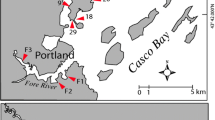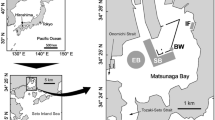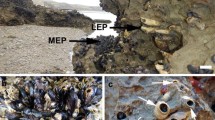Abstract
The shore zones of the Hudson River, like those of many developed waterways, are highly varied, containing a mix of seminatural and highly engineered shores. Our goal was to document the biodiversity supported by different kinds of shore zones in the Hudson. We chose six common types of shore zones, three of them “natural” (sand, unconsolidated rock, and bedrock), and three of them engineered (riprap, cribbing, and bulkheads). We measured selected physical characteristics (shore zone width, exposure, substrate roughness and grain size, shoreline complexity) of three examples of each of these shore types, and also sampled communities of terrestrial plants, fishes, and aquatic and terrestrial invertebrates. Community composition of most taxa differed across shore types, and frequently differed between wide, sheltered shores and narrow, exposed shores. Alien plant species were especially well represented along engineered shores. Nevertheless, a great deal of variation in biological communities was not explained by our six-class categorization of shore zones or the physical variables that we measured. No single shore type supported the highest values of all kinds of biodiversity, but engineered shore zones (especially cribbing and bulkheads) tended to have less desirable biodiversity characteristics than “natural” shore zones.





Similar content being viewed by others
References
Airoldi L, Beck MW (2007) Loss, status and trends for coastal marine habitats of Europe. Oceanogr Marine Biol Annu Rev 45:345–405
Backlund HO (1945) Wrack fauna of Sweden and Finland: ecology and chorology. Opuscula Entomologica Suppl 5:236 +6 plates
Bailey RC, Norris RH, Reynoldson TB (2001) Taxonomic resolution of benthic macro invertebrate communities in bioassessments. J North Am Benthol Soc 20:280–286
Barwick DH (2004) Species richness and centrarchid abundance in littoral habitats of three southern US reservoirs. North Am J Fish Manag 24:76–81
Bell EC, Denny MW (1994) Quantifying “wave exposure”: a simple device for recording maximum velocity and results of its use at several field sites. J Exp Mar Biol Ecol 181:9–29
Brauns M, Garcia F, Walz N, Pusch MT (2007) Effects of human shoreline development on littoral macro invertebrates in lowland lakes. J Appl Ecol 44:1138–1144
Brodersen KP (1995) The effect of wind exposure and filamentous algae on the distribution of surf zone macroinvertebrates in Lake Esrom, Denmark. Hydrobiologia 297:131–148
Burch JB (1962) How to know the eastern land snails. W.C Brown, Dubuque
Burch JB (1989) North American freshwater snails. Malacological Publications, Hamburg
Caraco NF, Cole JJ, Raymond PA, Strayer DL, Pace ML, Findlay SEG, Fischer DT (1997) Zebra mussel invasion in a large, turbid river: phytoplankton response to increased grazing. Ecology 78:588–602
Coupland CT, Duarte CM, Walker DI (2007) High metabolic rates in beach cast communities. Ecosystems 10:1341–1350
Davis MA, Grime JP, Thompson K (2000) Fluctuating resources in plant communities: a general theory of invasibility. J Ecol 88:528–534
Doyle MW, Stanley EH, Havlick DG, Kaiser MJ, Steinbach G, Graf WL, Galloway GE, Riggsbee JA (2008) Aging infrastructure and ecosystem restoration. Science 319:286–287
Ekebom J, Laihonen P, Suominen T (2003) A GIS-based step-wise procedure for assessing physical exposure in fragmented archipelagos. Estuar Coast Shelf Sci 57:887–898
Frost NM, Burrows MT, Johnson MP, Hanley ME, Hawkins SJ (2005) Measuring surface complexity in ecological studies. Limnol Oceanogr Methods 3:203–210
Geyer WR, Chant R (2006) The physical oceanography processes in the Hudson River estuary. In: Levinton JS, Waldman JR (eds) The Hudson River estuary. Cambridge University Press, New York, pp 24–38
Gotelli NJ, Ellison AM (2004) A primer of ecological statistics. Sinauer, Sunderland
Harman WN, Berg CO (1971) The freshwater snails of central New York with illustrated keys to the genera and species. Search (Cornell University Agricultural Experiment Station) 1(4):1–68
Jokinen EH (1992) The freshwater snails (Mollusca: Gastropoda) of New York state. NY State Mus Bull 482:1–112
Keddy PA (1982) Quantifying within-lake gradients of wave energy: interrelationships of wave energy, substrate particle size and shoreline plants in Axe Lake, Ontario. Aquat Bot 14:41–58
Kennedy TL, Turner TF (2011) River channelization reduces nutrient flow and macroinvertebrate diversity at the aquatic terrestrial transition zone. Ecosphere 2 (art35). doi:10.1890/ES11-00047.1
Lazorchak JM, Klemm DJ, Peck DV (eds) (1998) Environmental Monitoring and Assessment Program—surface waters: field operations and methods for measuring the ecological condition of wadeable streams. EPA/620/R-94/004F. United States Environmental Protection Agency, Washington, DC
Lenat DR, Resh VH (2001) Taxonomy and stream ecology—the benefits of genus- and species-level identification. J North Am Benthol Soc 20:287–298
McCune B, Grace JB (2002) Analysis of ecological communities. MjM Software Design, Gleneden Beach
McLachlan A, Brown AC (2006) The ecology of sandy shores, 2nd edn. Academic Press, San Diego 392 pp
Minchinton TE (2002) Disturbance by wrack facilitates spread of Phragmites australis in a coastal marsh. J Exp Mar Biol Ecol 281:89–107
National Research Council (2007) Mitigating shore erosion along sheltered coasts. The National Academies Press, Washington DC, 174 p
Nieder WC, Barnaba E, Findlay SEG, Hoskins S, Holochuck N, Blair EA (2004) Distribution and abundance of submerged aquatic vegetation and Trapa natans in the Hudson River estuary. J Coast Res 45:150–161
Paetzold A, Yoshimura C, Tockner K (2008) Riparian arthropod responses to flow regulation and river channelization. J Appl Ecol 45:894–903
Petticrew EL, Kalff J (1991) Calibration of a gypsum source for fresh-water flow measurements. Can J Fish Aquat Sci 48:1244–1249
Pilsbry HA (1939–1948) The land Mollusca of North America (north of Mexico). Academy of natural sciences at Philadelphia monograph 3, vols 1 and 2
Pister B (2009) Urban marine ecology in southern California: the ability of riprap structures to serve as rocky intertidal habitat. Mar Biol 156:861–873
Polis GA, Hurd SD (1996) Linking marine and terrestrial food webs: allochthonous input from the ocean supports high secondary productivity on small islands and coastal land communities. Am Nat 147:396–423
Pollock MM, Naiman RJ, Hanley TA (1998) Plant species richness in riparian wetlands: a test of biodiversity theory. Ecology 79:94–105
Sabo JL, Sponseller R, Dixon M, Gade K, Harms T, Heffernan J, Jani A, Katz G, Soykan C, Watts J, Welter J (2005) Riparian zones increase regional species richness by harboring different, not more, species. Ecology 86:56–62
Sass GG, Kitchel JF, Carpenter SR, Hrabik TR, Marburg AE, Turner MG (2006) Fish community and food web responses to a whole-lake removal of coarse woody habitat. Fisheries 31:321–330
Scholten M, Anlauf A, Bűchele B, Faulhaber P, Henle K, Kofalk S, Leyer I, Meyerhoff J, Purps J, Rast G, Scholz M (2005) The River Elbe in Germany—present state, conflicting goals, and perspectives of rehabilitation. Archiv fűr Hydrobiologie Supplementband 155:579–602
Simpson KW, Fagnani JP, DeNicola DM, Bode RW (1985) Widespread distribution of some estuarine crustaceans (Cyathura polita, Chiridotea almyra, Almyracuma proximoculi) in the limnetic zone of the lower Hudson River, New York. Estuaries 8:373–380
Simpson HJ, Chillrud SN, Bopp RF, Schuster E, Chaky DA (2006) Major ion geochemistry and drinking water supply issues in the Hudson River basin. In: Levinton JS, Waldman JR (eds) The Hudson River estuary. Cambridge University Press, New York, pp 79–96
Strayer DL (1990) Freshwater Mollusca. In: Peckarsky BL, Fraissinet PR, Penton MA, Conklin DJ (eds) Freshwater macroinvertebrates of northeastern North America. Cornell University Press, Ithaca, pp 335–372
Strayer DL, Findlay SEG (2010) Ecology of freshwater shore zones. Aquat Sci 72:127–163
Strayer DL, Smith LC (2001) The zoobenthos of the freshwater tidal Hudson River and its response to the zebra mussel (Dreissena polymorpha) invasion. Arch Hydrobiol Suppl 139:1–52
Strayer DL, Smith DR (2003) A guide to sampling freshwater mussel populations. Am Fish Soc Monogr 8:1–103
Tockner K, Stanford JA (2002) Riverine floodplains: present state and future trends. Environ Conserv 29:308–330
Ward JV, Tockner K, Schiemer F (1999) Biodiversity of floodplain river ecosystems: ecotones and connectivity. Regul Rivers Res Manage 15:125–139
Wetzel RG (1990) Land-water interfaces: metabolic and limnological regulators. Verhandlungen der Internationale Vereinigung fűr Theoretische und Angewandte Limnologie 24:6–24
Acknowledgments
We thank the Hudson River Foundation, the Tibor T. Polgar Fellowship program, and the Cooperative Institute of Coastal and Estuarine Environmental Technology for financial support. We appreciate technical assistance from Noah Beck, Zara Dowling, Deana Grimaldi, Robin Schmidt, and Andy Snyder, encouragement from Betsy Blair, and very helpful comments from two anonymous reviewers.
Author information
Authors and Affiliations
Corresponding author
Rights and permissions
About this article
Cite this article
Strayer, D.L., Findlay, S.E.G., Miller, D. et al. Biodiversity in Hudson River shore zones: influence of shoreline type and physical structure. Aquat Sci 74, 597–610 (2012). https://doi.org/10.1007/s00027-012-0252-9
Received:
Accepted:
Published:
Issue Date:
DOI: https://doi.org/10.1007/s00027-012-0252-9




